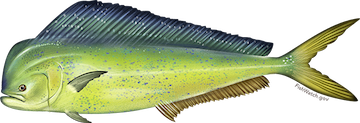391116-dolphinfish.png

Dolphinfish, or mahi-mahi, are a sustainable seafood choice. Credit: NOAA Fishwatch.gov
For a guilt-free sport fish that also tastes good, you might consider the dolphinfish, which today is probably better known as mahi-mahi. Even though the numbers caught by both recreational anglers and commercial fishing fleets have increased in recent years, the population seems to be stable. As a result, it’s not on any “endangered” lists. Instead, it’s on many “recommended” lists as a good, sustainable seafood choice.
The dolphinfish is found in tropical and sub-tropical waters around the world. It’s brightly colored — electric blue-green on top, gold or silver on the bottom, with light and dark spots on the sides. A typical adult is a few feet long and weighs 20 or 30 pounds. It lurks below mats of floating seaweed, which is a popular gathering spot for its preferred food. But it’s also found in open waters at depths of up to a hundred feet or so.
The Pacific dolphinfish has become an especially popular catch in recent years. It’s fished off Hawaii and California. In 2013, commercial fleets brought in about 1.5 million pounds.
Even so, pressure on the dolphinfish is low. That’s because it reproduces like crazy. It reaches sexual maturity by the age of four or five months. By that time, it’s grown from a tiny larva to perhaps a foot-and-a-half long, and weighs a few pounds. A female can spawn several times a year, and produce hundreds of thousands of eggs. That helps keep the overall species strong and vibrant — and a popular choice for both gourmets and environmentalists.
This episode of Science and the Sea was made possible by Chuck Nash Auto Group of San Marcos, Texas.

